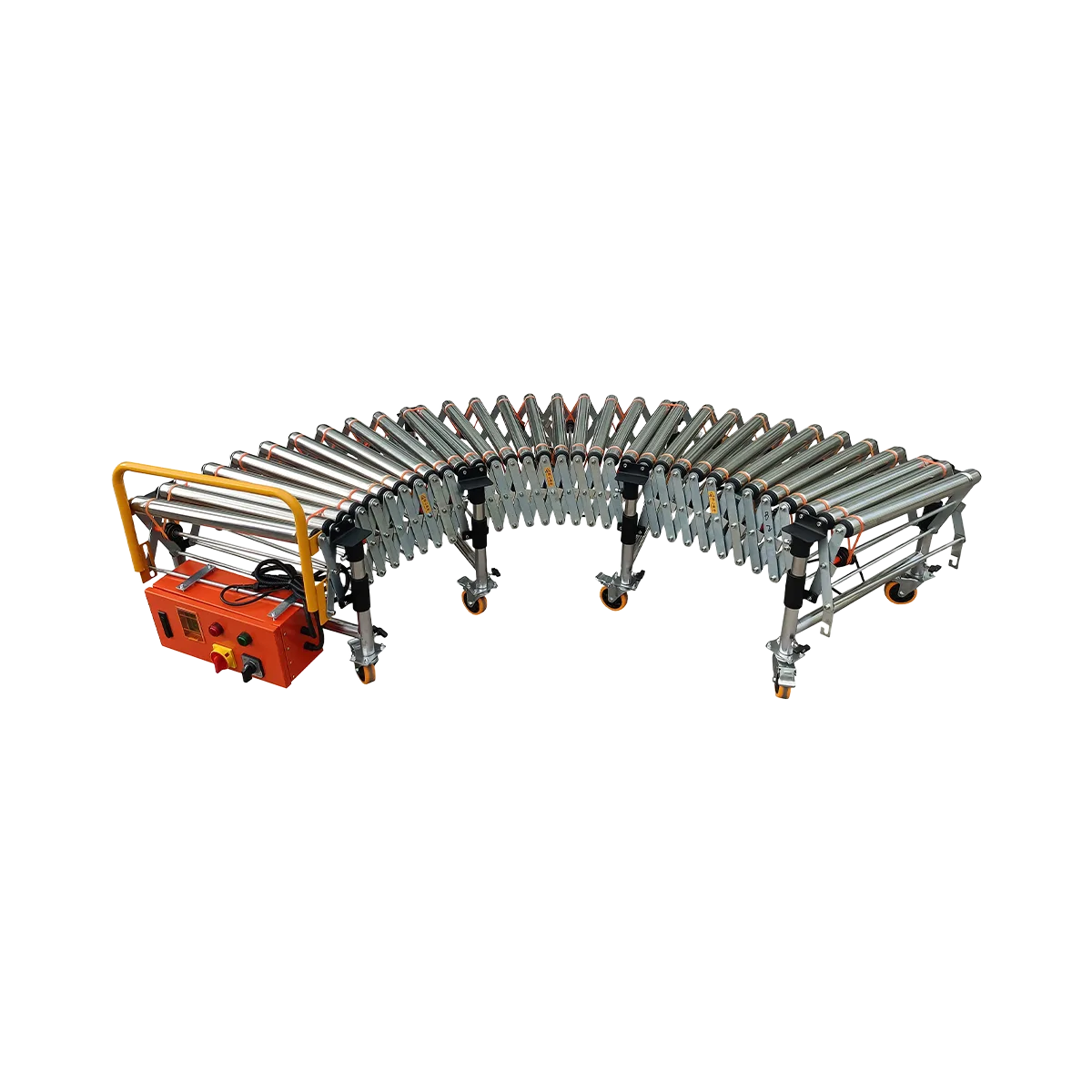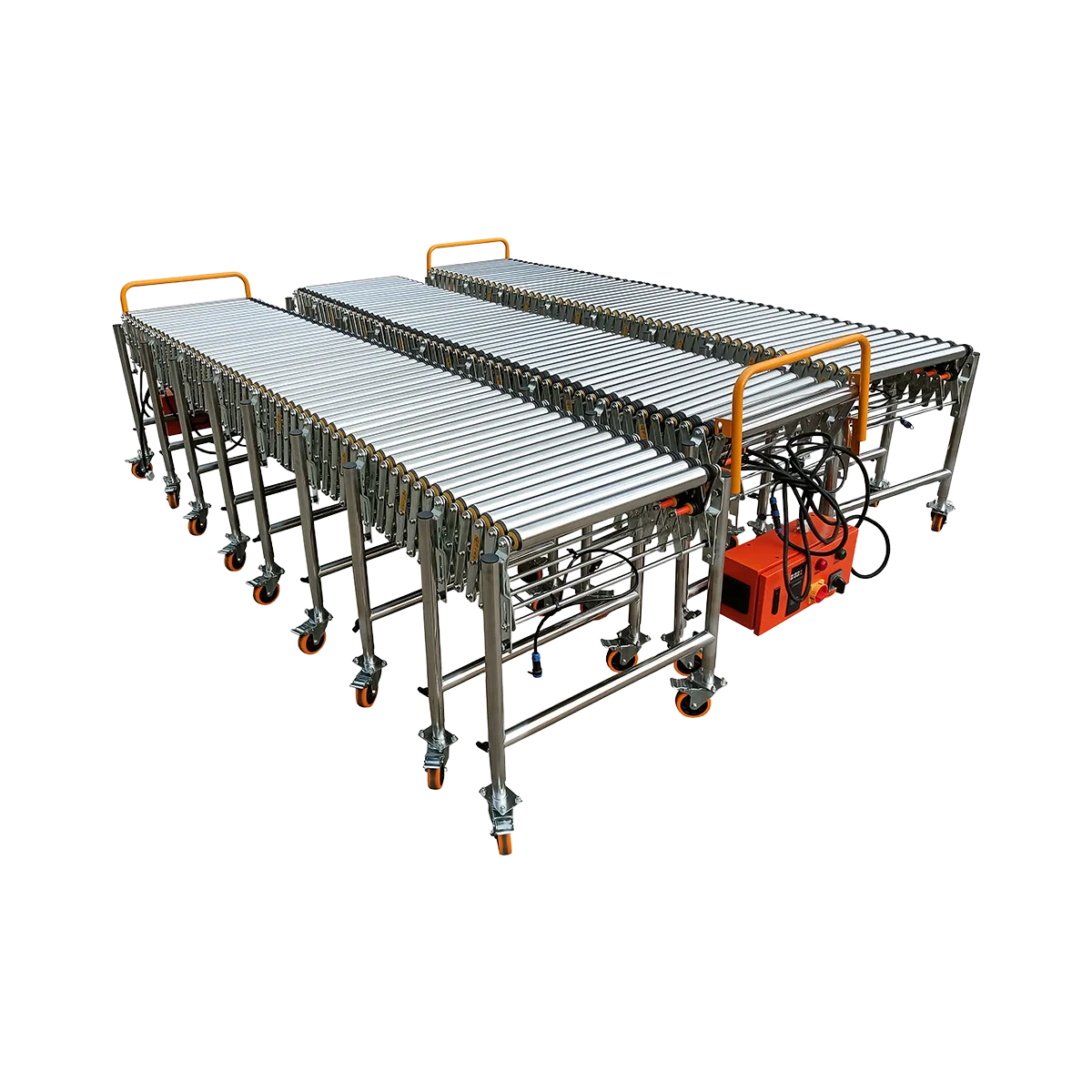Loading and Unloading Solutions for Air Cargo Containers
Optimize your air cargo conveyor systems for faster turnaround times and safer handling. Our guide to airport logistics systems ensures efficient air freight handling solutions.
Related Products
-
Powered Roller Conveyor – O-shaped Belt Driven – 1500 mm/SectionCollapsed Length
525 mm
Extended Length1500 mm
Load Capacity80 kg/m
Applicable GoodsFlat-bottomed Goods
-
Powered Roller Conveyor – Multi-wedge Belt Driven – 2000 mm/SectionCollapsed Length
700 mm
Extended Length2000 mm
Load Capacity100 kg/m
Applicable GoodsFlat-bottomed Goods
-
Powered Roller Conveyor – Multi-wedge Belt Driven – 3000 mm/SectionCollapsed Length
1050 mm
Extended Length3000 mm
Load Capacity80 kg/m
Applicable GoodsFlat-bottomed Goods
In the fast-paced world of air freight, efficiency and careful handling are paramount concerns. Air cargo operations demand solutions that balance rapid turnaround with meticulous cargo treatment. An effective air cargo conveyor system is the backbone of any successful airport logistics operation, providing the speed, reliability, and cargo protection needed to maintain competitive advantage in the industry. With air freight volumes continuing to grow globally, cargo terminals face increasing pressure to process Unit Load Devices (ULDs) and loose cargo efficiently while preventing damage.
Air cargo terminals operate in an environment where minutes matter and proper handling directly impacts the bottom line. The right equipment makes all the difference between smooth operations and costly delays. Whether handling delicate electronics, perishable goods, or standard freight, the conveyor systems connecting aircraft to cargo facilities must offer both speed and stability.
The Air Cargo Challenge
Meeting Tight Turnaround Windows
Aircraft on the ground represent significant costs for airlines and cargo operators. Every minute an aircraft spends waiting for cargo to be loaded or unloaded translates to operational expenses and potential delays rippling through the schedule. This creates several critical challenges:
- Rapid unloading requirements: Wide-body cargo aircraft may contain 30+ ULDs that need to be unloaded quickly
- Loading precision: Cargo must be loaded according to specific weight distribution plans
- Transfer cargo pressures: Items connecting to other flights may have extremely tight transfer windows
- Weather and operational constraints: Outdoor operations are subject to weather delays, increasing the need for efficiency when conditions permit
Airport logistics systems must be designed to minimize ground time while maintaining careful handling standards. The ideal air freight handling equipment must be durable enough to withstand continuous use in demanding environments yet gentle enough to protect valuable cargo.
Careful Handling Requirements
Air cargo encompasses everything from delicate electronics to industrial machinery, each with specific handling requirements:
- Fragile electronics: Require smooth movement without jarring or impact
- Pharmaceutical products: Demand careful handling to maintain packaging integrity
- Aircraft parts: High-value components requiring precise handling
- Standard freight: General cargo needing efficient movement without damage
Additionally, air cargo containers themselves represent a significant investment. ULDs (Unit Load Devices) cost thousands of dollars each, and damage to these specialized containers creates both replacement costs and operational delays when they must be removed from service.
To address these challenges, cargo terminals need conveyor systems specifically designed for the unique demands of air freight operations—equipment that can withstand the rigors of continuous use while providing the gentle handling that valuable cargo requires.
The Naili Solution: Powered Roller Conveyor Systems
Among the various options for air cargo terminal equipment, Naili’s Powered Roller Conveyor systems stand out as particularly well-suited for air freight handling operations. These systems offer the ideal combination of speed, reliability, and cargo protection required in the demanding air cargo environment.
High-Speed Operation for Quick Aircraft Turnaround
The multi-wedge belt drive Powered Roller Conveyor with 2000mm/section excels in air cargo applications for several key reasons:
- Superior speed control: Variable speed from 0.3-40 m/min allows operators to adjust throughput based on cargo type and handling requirements
- Enhanced load capacity: With 100 kg/m rating, these conveyors easily handle even the heaviest air cargo parcels
- Modular design: Conveyor sections can be connected to create custom configurations matching terminal layout requirements
- Bidirectional operation: Forward/reverse control enables flexible cargo movement depending on operational needs
- Reliability under pressure: Industrial-grade components ensure consistent performance during peak handling periods
The 50mm diameter rollers with 100mm spacing provide excellent support for cargo of various sizes, from small packages to larger items. This roller configuration ensures smooth transitions between conveyor sections while maintaining package stability—a critical factor when handling high-value air freight.
For air cargo applications requiring maximum flexibility, the O-belt drive model with 1500mm sections offers slightly lower capacity (80 kg/m) but provides even greater adaptability for temporary configurations or specialized handling areas.
Smooth Transport for Delicate Cargo
Air freight often includes sensitive electronics, medical supplies, and other items requiring gentle handling. The Powered Roller Conveyor system addresses these needs through:
- Smooth start/stop capability: Variable frequency drive prevents sudden movements that could damage delicate items
- Consistent roller rotation: Multi-wedge belt drive ensures all rollers turn at the same speed, preventing package scuffing
- Even weight distribution: Closely spaced rollers distribute package weight evenly, protecting both cargo and containers
- Precise speed control: Operators can reduce speed for handling sensitive items when necessary
The system’s control panel includes emergency stop buttons, allowing immediate halting of the conveyor in case of package jams or other issues. This level of control is essential when handling the diverse cargo types typical in air freight operations.
Additionally, the height-adjustable legs (ranging from 450-1500mm) enable perfect alignment with aircraft loaders, truck beds, and warehouse systems. This height flexibility eliminates the need to lift packages manually between different levels, reducing both labor requirements and the risk of handling damage.
Implementation Guide for Air Cargo Terminals
Setting Up Temporary Cargo Processing Lines
One of the greatest challenges in air cargo operations is adapting to changing volumes and requirements. During peak seasons or when handling special shipments, terminals need to quickly establish additional processing capacity. The powered conveyor systems from Naili are ideally suited for creating temporary processing lines:
- Rapid deployment: The telescopic design allows quick extension to operational length
- Minimal storage footprint: When not in use, conveyors collapse to approximately one-third of their extended length
- Easy mobility: 4-inch caster wheels with full braking capability allow conveyors to be positioned precisely where needed
- Simple connection: Multiple conveyor sections can be joined to create longer lines or complex configurations
- Independent operation: Each section includes its own drive system, allowing standalone use
For temporary installations, the height-adjustable legs can be set to match existing infrastructure, ensuring smooth package transfers between permanent and temporary systems. This flexibility is particularly valuable during peak seasons when air cargo volumes may increase dramatically.
Managing Different ULD Sizes and Cargo Types
Air cargo operations must handle a wide variety of ULD sizes and cargo types. Modern ULDs range from LD3 containers to full PMC pallets, each with different dimensions and handling requirements. A flexible air freight handling system must accommodate this diversity.
The 800mm width option for Powered Roller Conveyors provides ample surface area for handling loose cargo unloaded from various ULD types. For terminals processing many small packages, the 600mm width offers a more space-efficient solution while still accommodating standard air cargo dimensions.
To maximize operational efficiency, terminals should consider these arrangement options:
- Parallel processing lines: Multiple conveyor lines operating in parallel for simultaneous handling of cargo from different aircraft or destinations
- Sorting spurs: Branch lines directing cargo to specific processing areas based on destination or special handling requirements
- Accumulation zones: Areas where cargo can temporarily queue before downstream processing
- Workstations: Dedicated spaces along conveyor lines for documentation processing, security screening, or special handling
These configurations can be quickly modified as operational needs change, providing the adaptability essential in the dynamic air cargo environment.
Maintenance Considerations for High-Throughput Operations
Air cargo terminals operate under intense pressure, often 24 hours a day. Equipment reliability is non-negotiable in this environment, making proper maintenance essential. For Powered Roller Conveyor systems in air freight applications, maintenance focus should include:
- Drive belt inspection: Regular checks of multi-wedge or O-belts for proper tension and wear (monthly recommended)
- Roller bearing maintenance: Quarterly lubrication to ensure smooth operation
- Control system testing: Monthly verification of emergency stops and directional controls
- Caster condition: Regular inspection of mobility components, especially for temporary installations
With proper maintenance, these systems can deliver 5-10+ years of reliable service even in demanding air cargo environments. The frame warranty of 12 months and belt warranty of 6 months cover the initial break-in period, but proper care significantly extends useful life well beyond the warranty period.
Conclusion: Keep Air Cargo Moving at the Speed of Flight
Effective air cargo terminal equipment forms the critical link between aircraft and distribution networks. By implementing the right loading and unloading conveyor solutions, air freight facilities can achieve the perfect balance of speed and careful handling that the industry demands.
Naili’s Powered Roller Conveyor systems offer the ideal combination of features for air cargo applications:
- High-capacity design supporting even the heaviest air freight items
- Variable speed control for adapting to different cargo types
- Modular configuration for creating custom terminal layouts
- Reliable operation under demanding conditions
- Height adjustability for perfect integration with aircraft loaders and other systems
As air cargo volumes continue to grow globally, terminals that invest in efficient handling systems gain significant competitive advantages through faster aircraft turnaround, reduced labor requirements, and improved cargo protection. The right conveyor solution doesn’t just move packages—it transforms the entire operation, keeping air cargo moving at the speed of flight.
Frequently Asked Questions
What conveyor width is best for air cargo handling applications?
For most air cargo terminals, the 800mm width conveyor provides optimal versatility for handling various ULD contents. However, facilities primarily handling smaller packages may benefit from the space efficiency of 600mm models.
How should conveyor height be set for integration with aircraft loaders?
Conveyor height should be adjusted to match the specific aircraft loaders used at your facility, typically ranging from 508mm (20 inches) to 1,016mm (40 inches) from the ground. The adjustable legs (450-1500mm range) easily accommodate these requirements.
What speed settings are recommended for air cargo handling?
For general air cargo handling, 20-30 m/min typically provides optimal throughput. Reduce to 10-15 m/min for delicate items or when precise inspection is required, and use maximum speed (40 m/min) for rapid transfer of standard cargo during peak periods.
Can powered roller conveyors handle the weight of aircraft parts and heavy machinery?
The multi-wedge belt drive 2000mm model can handle items weighing up to 100kg/m, making it suitable for most aircraft parts and components. For exceptionally heavy items, consider using multiple conveyor sections to distribute the weight.
How quickly can temporary conveyor lines be set up during peak periods?
A team of two workers can typically deploy and connect 5-6 sections of powered roller conveyor within 30-45 minutes, creating approximately 10-12 meters of processing line. This allows cargo terminals to rapidly scale up capacity for peak demand periods.
Table of Contents
Recent Posts
Optimize hardware store logistics with the right building supply conveyor systems. Our guide to tool distribution systems enhances retail warehouse automation for efficient operations.
Optimize your medical supply logistics with efficient gravity conveyor systems. Learn how to safely handle healthcare products while improving your hospital supply chain operations.
Discover how a sports equipment conveyor system can streamline your athletic gear logistics. Flexible conveyor solutions for all shapes and sizes of sporting goods.
Optimize battery warehouse conveyor systems for UPS loading and safe battery transport. Our guide to efficient power cell logistics solutions ensures secure battery box handling.



